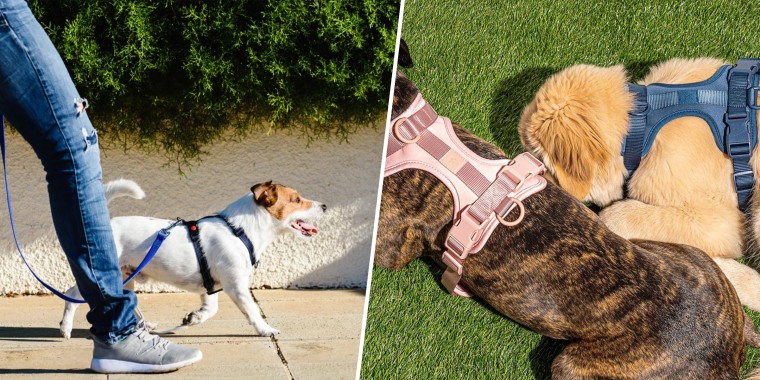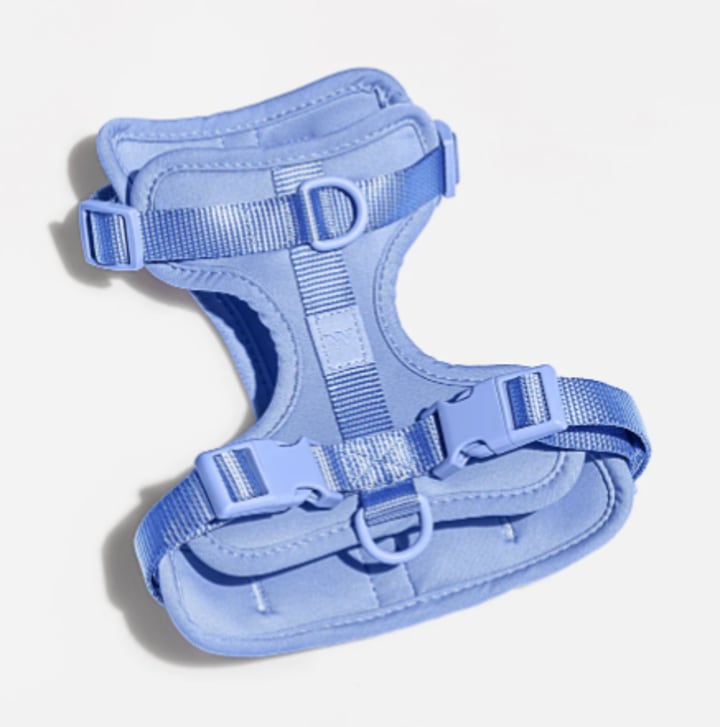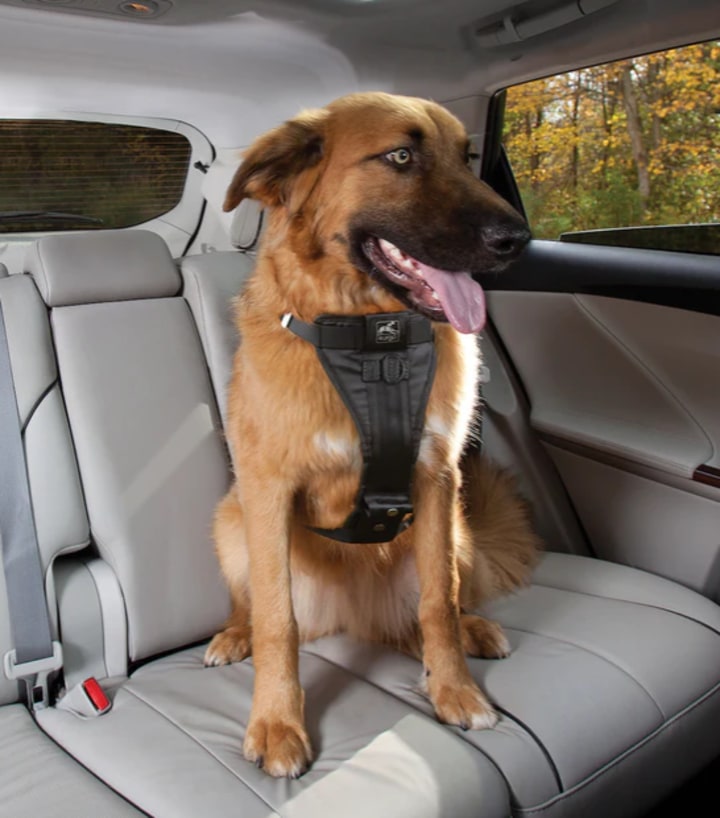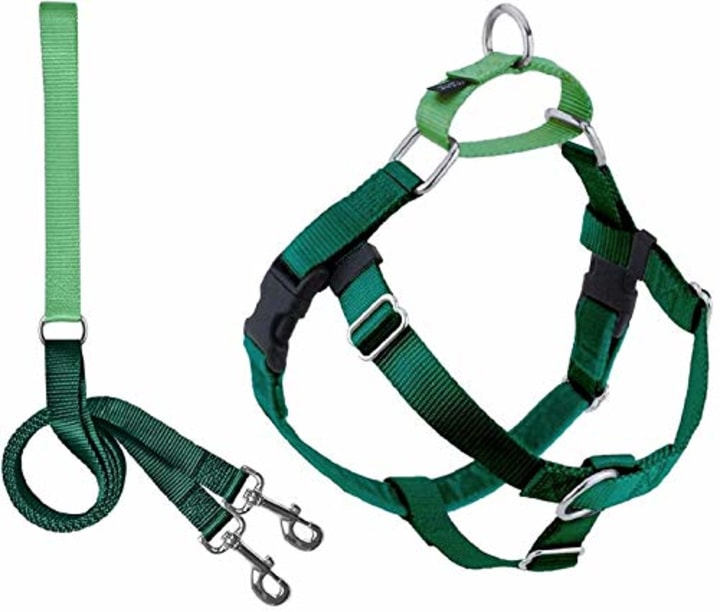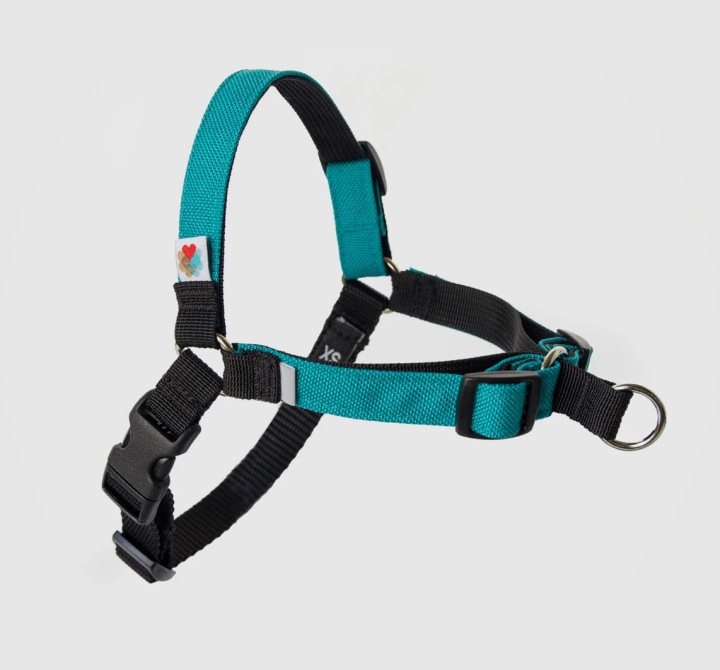For some, one of the best parts of having a dog is taking them on walks. Not only is it daily exercise — dog owners walk an average 22 minutes longer each day than non-dog owners, according to a study from BioMedCentral’s Public Health Journal — it can also be vital to your dog’s overall health. But if your dog constantly tugs or lunges while walking with a traditional collar and leash, experts told us a harness can be a good alternative. These walking tools can help disperse the pressure caused by a pulling leash, which can be better for your dog's neck and help prevent them from choking.
SKIP AHEAD Types of dog harnesses | Best dog harnesses to shop | How to find the right harness for your dog
“I always prefer harnesses — they limit pull and pressure on the windpipe, and disperse that pull across the front of the body in an even distribution,” explained Dr. Natalie Marks, a veterinarian at VCA Blum Animal Hospital in Chicago.
If you’re looking to invest in a harness for your pup, here's what veterinarians and dog trainers told Select about the different types available, the benefits of using each one and how to find the best fit for your dog. We also compiled some of their favorite dog harnesses to consider.
Dog harnesses versus collars: Which one is best?
Ultimately, the choice between a harness and collar is a matter of personal preference and what works for your lifestyle, as well as the temperament and training of the dog wearing it. “If a dog is already trained to happily walk at your side, then a flat buckle collar is a fine choice,” said Robert Haussmann, a certified dog trainer and co-founder of dog training service Dogboy NYC.
However, if you’re looking for a tool to help teach your dog leash manners, Haussman said he prefers a harness because it keeps the pressure off their trachea and spine if they pull, drag back or unpredictably lunge forward.
Types of dog harnesses
Choosing the right type of harness can make a big difference when it comes to how comfortable and obedient a dog is during walks. There are two main styles of harnesses: back-clip and front-clip (also called no-pull harnesses). Our experts broke down the benefits and limitations of each type and explained which one may be better depending on your dog’s size, training and overall demeanor.
Back-clip harnesses
Benefits: Back-clip harnesses let you clip the leash in between your dog’s shoulder blades. They’re usually more comfortable for dogs and are less likely to tangle around their legs compared to front-clip harnesses, according to Alison Creighton, a registered veterinary technician at VCA Lakewood Animal Hospital.
Drawbacks: These types of harnesses may encourage your dog to pull more since they can rest their entire body weight against the front. This is especially true for dogs who are just learning to walk or already have a pulling habit, Haussmann said.
Front-clip harnesses
Benefits: All dogs have an oppositional reflex: When they feel pressure, they tend to pull or push against it. “A harness that has the leash attachment in the front tends to help bypass this reflex [because] the dog has a harder time pushing against the pressure of the harness,” Haussmann said. That means you can pull your dog back gently and teach them good leash manners without putting pressure on their trachea or spine.
Drawbacks: Front-clip harnesses can be awkward to get used to for both you and your dog because the leash hangs in front. Haussman noted that if you leave too much leash dangling, it can get tangled under the dog's legs; too little and your dog can get used to the tension, causing them to try to pull more. These harnesses can also backfire if you have a dog who chooses not to walk at all. “That reflex to pull against the pressure works in both directions: If you’re pulling from the front while your dog leans back into the harness, you can make a bad habit worse,” Haussmann said.
Best dog harnesses to shop
Below, we compiled expert-recommended back- and front-clip dog harnesses that can work with your dog’s training, demeanor and size. In line with our experts’ guidance, each of the following dog harnesses are available in multiple sizes and include a size guide to find the one that’s right for your dog’s body type and weight.
Best dog harness overall: Wild One
Wild One Harness
“This harness looks good, is well constructed and comes with really nice matching leashes,” Haussmann said.
Wild One’s harness is also a favorite of Select editorial operations manager, Shari Uyehara, for her 1-year-old, 18-pound cavalier King Charles spaniel, Loki, because it's stylish and fits well. The harness has to be slipped over the dog’s head instead of clipped around their body, which Uyehara said can take some getting used to: “It requires a little wiggling at first, but after you do it a few times, you get used to it,” she said.
A leash can be attached to the harness in three spots — the neck, lower back and chest — for your preferred control method. It’s made from polyester and nylon and the brand says it’s designed for a stretchy, soft fit. Choose from trendy colors, including Spruce, Lilac, Blush and Strawberry, and you can also upgrade to a Walk Kit with a matching leash and poop bag carrier.
Best crash-tested dog harness: Kurgo
Kurgo Tru-Fit Harness
Haussmann called this Kurgo harness “sturdy and well-made” — and in addition to its padded chest plate and steel hardware, this durable harness includes a 10-inch seatbelt tether that’s been crash-tested for dogs up to 75 pounds, according to the brand. Like the Wild One harness, Kurgo’s Tru-Fit allows you to attach a leash both at the front and the back. The harness is also machine-washable and comes in red and black.
Best harness for large dogs: Petsafe
PetSafe Easy Walk Dog Harness
Haussmann recommended the front-clip Petsafe Easy Walk Harness because it’s the “easiest to find at pet stores and comes in half sizes to find the right fit,” he said. Select associate updates editor Zoe Malin’s family uses this harness to help steer their 9-year-old, 100-pound yellow lab Chance in the right direction. It has a patented loop design that puts gradual pressure on your dog's shoulders to help you safely redirect their focus and prevent them from pulling, according to the brand. It’s available in eight colors — including pink, red, teal and green — and its belly strap comes in a different color, which can help you see whether it’s being placed correctly on your dog.
Best harness for small dogs: Frisco
Frisco Small Breed Soft Vest Dog Harness
Look for a lightweight mesh or breathable harness if you have a small dog, a younger puppy or a pet that’s previously suffered a neck injury, Marks suggested. This option from Frisco is available in a range of smaller sizes and is made with soft mesh to keep your dog comfortable, according to the brand. It also includes reflective bands around the chest and sides for night-time walks. You can choose from pink, red, blue or black.
Best training dog harness: 2 Hounds Design
2 Hounds Design Freedom Harness
If you’re in the thick of training, the no-pull Freedom Harness will tighten around the dog’s chest to reduce tugging and allow you to steer them as needed. “This harness has both a front and back leash attachment, and it even comes with a leash,” Haussmann said. It also includes a comfortable, velvet-lined chest strap that helps prevent it from chaffing your dog’s skin, he added. The brand says the harness is designed to fit dogs weighing between 14 pounds up to 250 pounds, and you can choose from more than a dozen colors.
Best adjustable dog harness: Wildebeest
Wildebeest Linden No Pull Dog Harness
Wildebeest’s no-pull dog harness — which Haussmann said is both functional and durable — offers four highly adjustable straps along with a single buckle to easily get it on or off, according to the brand. The harness’s front-clip design has a strap that gently tightens around the chest to help control your dog’s pulling, and there are reflective details for night visibility, Wildebeest says. It comes in six colors, including pink, green and blue.
Best escape-proof dog harness: Harness Lead
Harness Lead Leash
Haussmann recommended the Harness Lead Leash for dogs who tend to be a flight risk “since they’re fairly escape-proof and effective at gently controlling pulling or dragging back,” he said. Though this is a back-clip option, it works similar to a no-pull harness in that it uses the dog’s own pressure to gently tighten around their chest and discourage tugging in the process, according to the brand. The durable, double-braided polyester harness comes two sizes to fit dogs between 14 pounds and 170 pounds, Harness Lead says. It's available in six colors.
How to find the right harness for your dog
In addition to determining whether a front- or back-clip harness is best for your dog, it’s important to pick one that is proportionate to your dog’s size. “A harness that's too tight can be painful, cause skin abrasions and can create a negative association with walking in general,” Marks said. A harness that is too loose, on the other hand, can prevent it from serving its intended purpose and let your dog wiggle right out of it, Creighton noted.
A general rule of thumb to determine whether the harness fits properly is you should be able to get two of your fingers between your dog’s body and the straps of the harness, according to Haussmann. “Be sure the front strap isn’t too low and hanging, or that it’s not rubbing too much under their armpits,” he added.
Harness manufacturers will usually include a size guide and instructions on how to properly measure your dog to get the correct fit. “How a harness fits will vary depending on the brand and type, so it is very important to follow measurement guidelines for each individual product,” Creighton said.
Meet our experts
At Select, we work with experts who have specialized knowledge and authority based on relevant training and/or experience. We also take steps to ensure that all expert advice and recommendations are made independently and with no undisclosed financial conflicts of interest.
Dr. Natalie Marks, a veterinarian at VCA Blum Animal Hospital in Chicago and certified veterinary journalist.
Robert Haussmann, a certified dog trainer and co-founder of dog training service Dogboy NYC.
Alison Creighton, a registered veterinary technician at VCA Lakewood Animal Hospital.
Catch up on Select's in-depth coverage of personal finance, tech and tools, wellness and more, and follow us on Facebook, Instagram and Twitter to stay up to date.
